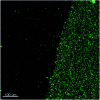Feasibility and constraints of particle targeting using the antigen-antibody interaction
- PMID: 24170264
- PMCID: PMC4047836
- DOI: 10.1039/c3nr04340a
Feasibility and constraints of particle targeting using the antigen-antibody interaction
Abstract
This work is concerned with the surface modification of fluorescent silica nanoparticles by a monoclonal antibody (M75) and the specific bioadhesion of such particles to surfaces containing the PG domain of carbonic anhydrase IX (CA IX), which is a trans-membrane protein specifically expressed on the surfaces of several tumor cell lines. The adhesion strength of antibody-bearing silica nanoparticles to antigen-bearing surfaces was investigated under laminar flow conditions in a microfluidic cell and compared to the adhesion of unmodified silica nanoparticles and nanoparticles coupled with an unspecific antibody. Adhesion to cancer cells using flow cytometry was also investigated and in all cases the adhesion strength of M75-modified nanoparticles was significantly stronger than for the unmodified or unspecific nanoparticles, up to several orders of magnitude in some cases. The specific modification of nano- and microparticles by an antibody-like protein therefore appears to be a feasible approach for the targeting of tumor cells.
Figures












References
-
- Čejková J., Stěpánek F. Curr. Pharm. Des. 2013;19:6298–6314. - PubMed
-
- Zadrazil A., Tokarova V., Stepanek F. Soft Matter. 2012;8:1811–1816.
-
- Tokarova V., Pittermannova A., Cech J., Ulbrich P., Stepanek F. Soft Matter. 2012;8:1087–1095.
-
- Tokárová V., Kašpar O., Knejzlík Z., Ulbrich P., Štěpánek F. Powder Technol. 2013;235:797–805.
-
- Haufova P., Dohnal J., Hanus J., Stepanek F. Colloids Surf., A. 2012;410:52–58.
Publication types
MeSH terms
Substances
LinkOut - more resources
Full Text Sources
Other Literature Sources

